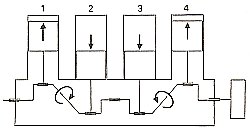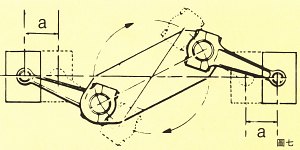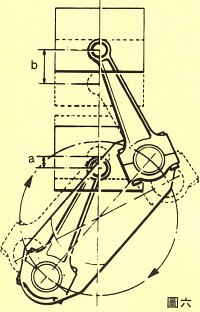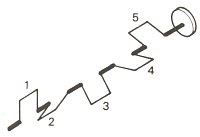Engine Smoothness
Inline 4-cylinder
engines (versus boxer 4-cylinder)
As commonly known, big straight-four
engine requires twin-balancer shafts rotating at twice the frequency as
the crankshaft to reduce vibration. This is very different to 3-cylinder
engines, which need a single balancer shaft running at the same frequency
as crankshaft. Obviously, the vibration generated by straight-four engines
is not the same as 3-cylinder engines.
I did some research into
this topic by mathematical analysis, also wrote a program to simulate the
vibration. The result is exactly the same as found in any textbooks. However,
to explain to you in simpler language, let us see in this way ...
 The
left pictures shows an inline-4 engine. It fires once every 720° /
4 = 180° crank angle, hence 2 of the pistons are in exactly the same
position and move in the same direction, while the remaining 2 pistons
are also a pair. To avoid the end-to-end vibration as experienced in 3-cylinder
engines, car makers always arrange the pistons as shown in the picture,
that is, symmetrical. In other words, piston 1 and 4 are a pair, while
piston 2 and 3 form another pair. Therefore movement of piston 1 will be
balanced by the symmetric piston 4. The same goes for piston 2 and 3.
The
left pictures shows an inline-4 engine. It fires once every 720° /
4 = 180° crank angle, hence 2 of the pistons are in exactly the same
position and move in the same direction, while the remaining 2 pistons
are also a pair. To avoid the end-to-end vibration as experienced in 3-cylinder
engines, car makers always arrange the pistons as shown in the picture,
that is, symmetrical. In other words, piston 1 and 4 are a pair, while
piston 2 and 3 form another pair. Therefore movement of piston 1 will be
balanced by the symmetric piston 4. The same goes for piston 2 and 3.
Thatís just the end-to-end
vibration with respect to the engine center. What about the resultant upward
/ downward vibration ? It seems that the movement of piston 1 is counter
balanced by piston 2, while piston 3 counters piston 4. However, this is
just skin-deep. More professional speaking, that just proves the balance
of 1st order force. The second order force (which can be derived from equation)
is normally much smaller than the 1st order force and it is rotating at
twice the frequency of the 1st order force. Nevertheless, the configuration
of inline-4 actually multiplies the magnitude of 2nd order force thus making
it hard to be ignored, especially is for larger engines.
A simpler explanation is
given in the below pictures, which compare a perfectly balanced boxer-4
engine with an inline-4 engine.
 Boxer (horizontally-opposed)
engine
Boxer (horizontally-opposed)
engine
|
 Inline engine
Inline engine
|
As seen, no matter where
the crankshaft rotates to, the boxer engine has the pair of pistons always
in opposite positions, directions and speeds, thus all the forces can be
balanced. (if not for packaging and cost reason, boxer engines would have
been the best choice) In contrast, in a straight-four engine, rotate the
crankshaft a certain angle, the piston near the top end has a displacement
(b), larger than that of another piston near the bottom (a). As vertical
force is the product of displacement and mass of piston and divided by
the time taken for such displacement, you can see the different displacements
must lead to different forces, therefore complete cancellation is impossible.
The resultant force is the aforementioned second order force, which rotates
at twice the speed of the crankshaft.
Solution - Twin-balancer shafts
The longer the stroke, the
heavier the pistons and con-rods, the more second order vibration generates.
Unfortunately, car makers favour straight-four engine for its advantages
of low cost and compact dimensions. Since the 80s, car engineers regard
4-pot engines larger than 2 litres in capacity had better to be equipped
with twin-balancer shafts to dampen the vibration. Although the strengthening
of engine block, the use of hydraulic engine mount and lightweight pistons
helped breaking such rule, the trend of pursuing refinement once again
led to many engines larger than 2 litres to use balancer shafts.
Balancer shaft was invented
by British automotive engineering master Dr. Frederick Lanchester in the
early 20th century. Mitsubishi obtained the patent and put it into mass
production in the 1976 Colt Celeste 2000, then Fiat group used it in its
Lamda engine series, including the 1.6-litre Delta HF turbo and Fiat Croma
/ Lancia Thema's 2-litre turbo. Meanwhile, Saab 9000 and Porsche 944 also
introduced it into their powerful inline fours. All these car makers obtained
license from Mitsubishi.


To deal with second order
vibration, a pair of balancer shafts is needed, driven by the engine and
rotate in opposite directions to each other, at twice the speed of the
crankshaft. They locate in either sides of the engine. One of them is positioned
just above the crank shaft level, the other is far above. Counter weights
on the balancer shafts will completely cancel the second order force, thus
result in a silky-smooth rotation.
The use of 2 balancer shafts
instead of a large single one is because the vibration generated by the
engine is mostly in vertical direction. 2 shafts rotating in opposite direction
can cancel each otherís transverse force and result in a net vertical force
which is used to balance the vibration.
Without twin-balancer shaft,
Porsche would have been impossible to make the 3-litre inline-four which
powered the 944 S2 and 968. Thatís the biggest four-cylinder engine in
modern cars.
Inline 5-cylinder engines
Straight-five engine is not
very common in motor industry. In the past 20 years, only Audi (2.2 and
2.3-litre), Honda (Acura TL), Volvo (2.0-litre, 2.3 turbo and 2.4-litre),
Fiat group (2.0 and 2.4-litre Super Fire series) and Mercedes diesel adopted
such design. However, straight-five engine has its own advantages. Firstly,
it bridges the gap between 4 and 6-cylinder engines, thus may offer the
best cylinder capacity for optimized efficiency; Secondly, compare with
4-cylinder engines, it saves one balancer shaft; Thirdly, compare with
6-cylinder engines, it is short enough to be fitted transversely into the
engine compartment of front-wheel-drive cars, driving directly the inline
gearbox. Lastly, it can be derived from a modular design consisting of
4 and 6-cylinder inline engines, not only saving development cost but also
eliminating the investment of a new production line. Fiat, Mercedes and
Volvoís 5-pots, for example, are made as modular engines.
The inline-5 engine fires
once every 720° / 5 = 144° crank angle. As a result, the crankshaft
design is as shown in below. Firing order is 1-3-5-4-2.


My mathematical analysis
proved that both its resultant first order force and second order force
are balanced. Therefore it doesnít need the twin-balancer shafts as a big
4-cylinder engine. However, it generates end-to-end vibration like 3-cylinder
engines, because piston 1 is not in the same position as piston 5, and
piston 2 is not in the same position as piston 4. Therefore both ends of
the engine will vibrate up and down with respect to the engine center.
Solution - single balancer shaft
Obviously, the solution is
the same as 3-pot engines, that is, employ a balancer shaft on which there
are counter weights moving in the opposite direction to the pistons. The
balancer shaft is driven by the engine at the same speed as the crankshaft.
Is that enough to make 5-cylinder
engine as smooth as 6-cylinder? no. For packaging reasons, the balancer
shaft cannot be placed in the most optimized position, that is, right above
or below the crankshaft. Therefore it has to be offset to either side of
the engine, resulting in incomplete cancellation of vibration.
Copyright©
1998-2000 by Mark Wan
AutoZine
Technical School
Return
to AutoZine home page
 The
left pictures shows an inline-4 engine. It fires once every 720° /
4 = 180° crank angle, hence 2 of the pistons are in exactly the same
position and move in the same direction, while the remaining 2 pistons
are also a pair. To avoid the end-to-end vibration as experienced in 3-cylinder
engines, car makers always arrange the pistons as shown in the picture,
that is, symmetrical. In other words, piston 1 and 4 are a pair, while
piston 2 and 3 form another pair. Therefore movement of piston 1 will be
balanced by the symmetric piston 4. The same goes for piston 2 and 3.
The
left pictures shows an inline-4 engine. It fires once every 720° /
4 = 180° crank angle, hence 2 of the pistons are in exactly the same
position and move in the same direction, while the remaining 2 pistons
are also a pair. To avoid the end-to-end vibration as experienced in 3-cylinder
engines, car makers always arrange the pistons as shown in the picture,
that is, symmetrical. In other words, piston 1 and 4 are a pair, while
piston 2 and 3 form another pair. Therefore movement of piston 1 will be
balanced by the symmetric piston 4. The same goes for piston 2 and 3.





